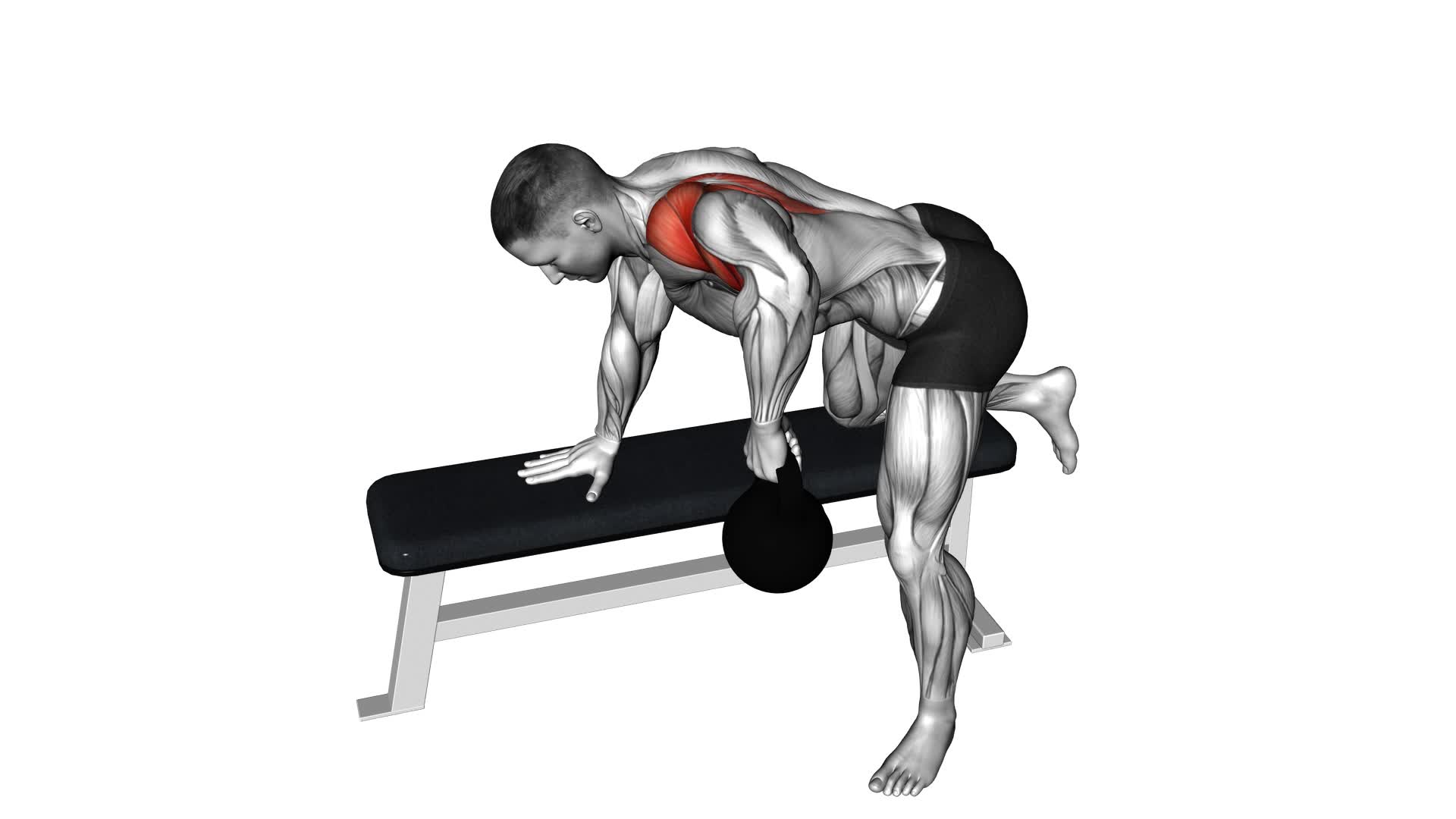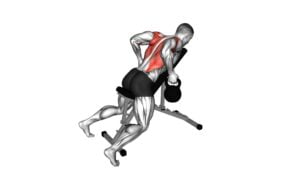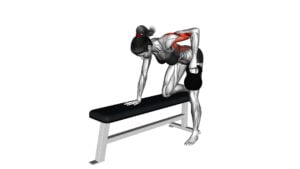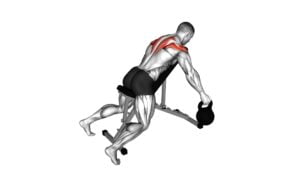Kettlebell Rear Delt Row – Video Exercise Guide & Tips

Are you looking to strengthen and tone your rear deltoids? Look no further than the kettlebell rear delt row.
Watch This Exercise Video
In this video exercise guide, we'll show you the proper technique and common mistakes to avoid. Plus, we'll provide variations and progressions to keep challenging yourself.
Maximize your rear delt activation with our tips and get ready for a killer workout. Get ready to level up your fitness game with the kettlebell rear delt row.
Let's get started!
Key Takeaways
- Kettlebell Rear Delt Row strengthens and tones rear deltoids, often overlooked muscles.
- It is crucial for shoulder stability, posture, and overall shoulder health.
- The exercise offers a greater range of motion compared to other rowing exercises.
- Maintaining proper form and technique is important to maximize benefits and reduce the risk of injury.
Benefits of Kettlebell Rear Delt Row
You can achieve stronger and more defined rear delts by incorporating the kettlebell rear delt row into your workout routine. This exercise targets the rear deltoid muscles, which are often overlooked but play a crucial role in shoulder stability and posture. By performing kettlebell rear delt row variations, you can add variety to your routine and effectively work your rear delts from different angles.
One of the benefits of the kettlebell rear delt row is that it allows for a greater range of motion compared to other rowing exercises. This helps to fully engage the rear delts and activate more muscle fibers. Additionally, using a kettlebell adds an element of instability, which challenges your core and improves overall balance and coordination.
To maximize rear delt development, it's important to train them with sufficient frequency. Aim to incorporate the kettlebell rear delt row into your routine at least twice a week. This will ensure that you're providing enough stimulus for muscle growth and strength gains.
Now that you understand the benefits of the kettlebell rear delt row, let's move on to discussing the proper technique for performing this exercise.
Proper Technique for Kettlebell Rear Delt Row
To perform the kettlebell rear delt row with proper technique, there are several key points to keep in mind.
First, focus on shoulder activation and stability throughout the movement to effectively target the rear delts.
Second, maintaining proper form not only maximizes the benefits of the exercise but also reduces the risk of injury.
Shoulder Activation and Stability
To ensure proper shoulder activation and stability during the Kettlebell Rear Delt Row, it's essential to maintain a strong and controlled grip on the kettlebell. By doing so, you engage the muscles in your shoulders, promoting shoulder stability and preventing any excessive movement or strain.
Additionally, focusing on your grip helps to improve your overall grip strength and forearm stability.
To further enhance shoulder activation and stability, it's recommended to incorporate shoulder mobility exercises into your routine. These exercises help to increase the range of motion in your shoulders, allowing for better movement and reduced risk of injury.
Strengthening exercises such as lateral raises and shoulder presses can also be beneficial in improving shoulder stability.
Remember to maintain proper form throughout the exercise and listen to your body to avoid any discomfort or pain.
Benefits of Proper Form
Maintaining proper form during the Kettlebell Rear Delt Row exercise is crucial for maximizing the benefits and effectiveness of the movement. When you perform this exercise with proper technique, you can ensure that you're targeting the correct muscles and engaging them fully.
Proper form helps in maximizing results by effectively working your rear deltoids, upper back, and shoulders. By keeping your core engaged and maintaining a neutral spine, you can prevent unnecessary strain on your lower back.
Additionally, maintaining the correct posture and shoulder position ensures that the targeted muscles are engaged throughout the movement, leading to better muscle activation and development.
Common Mistakes to Avoid
When performing the Kettlebell Rear Delt Row exercise, it's important to avoid common mistakes and maintain proper technique for optimal results. Here are four common mistakes to avoid when performing this exercise:
- Using too much weight: It's crucial to choose a weight that allows you to maintain proper form throughout the movement. Using too much weight can lead to poor technique and increase the risk of injury.
- Rounded shoulders: Keep your shoulders pulled back and down throughout the exercise. Avoid rounding your shoulders forward, as this reduces the activation of the rear deltoid muscles.
- Pulling with the arms: Remember that this exercise primarily targets the rear delts, not the biceps. Focus on initiating the movement from the rear delts and use your arms as secondary support.
- Swinging the kettlebell: Maintain control throughout the exercise and avoid using momentum to swing the kettlebell. This ensures that the rear deltoids are properly engaged, maximizing activation and effectiveness.
Common Mistakes to Avoid
Avoiding these common mistakes will help you get the most out of your kettlebell rear delt row exercise. To ensure proper form and maximize the effectiveness of the exercise, here are some tips for improvement.
One common mistake is using too heavy of a kettlebell. While it may be tempting to go for a heavier weight, using a weight that's too heavy can compromise your form and increase the risk of injury. Start with a lighter weight and gradually increase as you become more comfortable and confident with the movement.
Another mistake to avoid is rounding your back. It's important to maintain a neutral spine throughout the exercise to protect your lower back. Engage your core and keep your back straight as you perform the rowing motion.
Additionally, avoid using momentum to lift the kettlebell. This can diminish the effectiveness of the exercise and put unnecessary strain on your muscles. Instead, focus on using your rear deltoids to lift the weight, squeezing your shoulder blades together at the top of the movement for maximum engagement.
Lastly, rushing through the exercise is a common mistake to be aware of. Take your time and focus on proper form and technique. Control the movement both on the eccentric and concentric phases of the exercise to fully activate the muscles in your rear delts.
Variations and Progressions
To progress your kettlebell rear delt row exercise, you can explore various variations and progressions to challenge your muscles further. Here are four options to consider:
- Single-arm kettlebell rear delt row: Perform the exercise using only one arm at a time. This variation increases the demand on your stabilizing muscles and allows for greater focus on each side of your upper back.
- Alternating kettlebell rear delt row: Instead of performing the exercise with both arms simultaneously, alternate between each arm. This variation adds an element of coordination and balance to the exercise.
- Elevated kettlebell rear delt row: Place your feet on an elevated surface, such as a step or bench, while performing the exercise. This increases the range of motion and the challenge on your upper back muscles.
- Kettlebell rear delt row with pause: Add a pause at the top of each repetition. This variation increases the time under tension for your muscles, enhancing both strength and muscle endurance.
By incorporating these variations and progressions into your routine, you can continue to challenge your muscles and make progress in your kettlebell rear delt row exercise.
Remember to start with a weight that allows you to maintain proper form and gradually increase the load as you get stronger.
Tips for Maximizing Rear Delt Activation
To maximize rear delt activation during the kettlebell rear delt row, it's important to focus on proper form and technique.
Keep your back straight, engage your core, and pull the kettlebell towards your chest while squeezing your shoulder blades together.
Additionally, concentrate on targeting the specific muscle fibers by maintaining control throughout the movement and avoiding momentum or excessive swinging.
Proper Form and Technique
Maintain proper form and technique to maximize rear delt activation during the Kettlebell Rear Delt Row exercise. Follow these tips to ensure shoulder health and build muscle effectively:
- Stand with your feet hip-width apart, knees slightly bent, and hinge forward from the hips while keeping your back straight.
- Hold the kettlebell with an overhand grip, allowing it to hang directly below your shoulders.
- Engage your core and squeeze your shoulder blades together as you pull the kettlebell towards your chest, keeping your elbows close to your body.
- Pause for a moment at the top of the movement, then slowly lower the kettlebell back to the starting position.
Targeting Specific Muscle Fibers
To target specific muscle fibers and maximize rear delt activation during the Kettlebell Rear Delt Row exercise, focus on engaging your core and squeezing your shoulder blades together as you pull the kettlebell towards your chest.
By engaging your core, you create a stable base and increase muscle activation throughout your body.
Squeezing your shoulder blades together helps to isolate and activate the rear deltoid muscles specifically.
Additionally, maintaining proper form and technique is essential for optimizing muscle activation. Keep your back straight, chest up, and maintain a controlled and smooth movement throughout the exercise.
To further enhance muscle activation, gradually increase the training intensity by using heavier kettlebells or adding more repetitions.
Remember to listen to your body and gradually progress to avoid overexertion and injury.
Sample Kettlebell Rear Delt Row Workout
For an effective kettlebell rear delt row workout, incorporate a variety of exercises that target the rear deltoids. Here are four kettlebell exercises that will help you improve your upper body strength and develop strong rear deltoids:
- Kettlebell Rear Delt Row: Stand with your feet shoulder-width apart and hold a kettlebell in each hand. Bend forward at the waist, keeping your back straight and abs engaged. Pull the kettlebells up towards your chest, squeezing your shoulder blades together. Lower the kettlebells back down and repeat.
- Kettlebell High Pull: Start with a kettlebell between your feet. Squat down and grab the kettlebell with both hands. Explosively stand up, pulling the kettlebell up towards your chin, elbows high. Lower the kettlebell back down and repeat.
- Kettlebell Reverse Fly: Hold a kettlebell in each hand and hinge forward at the waist, keeping your back straight. Raise your arms out to the sides, squeezing your shoulder blades together. Lower the kettlebells back down and repeat.
- Kettlebell Upright Row: Stand with your feet shoulder-width apart and hold a kettlebell in each hand. Pull the kettlebells up towards your chin, keeping them close to your body. Lower the kettlebells back down and repeat.
Incorporating these kettlebell exercises into your routine will help you strengthen your rear deltoids and improve your upper body strength. Remember to start with a weight that challenges you but allows you to maintain proper form. Keep progressing by gradually increasing the weight as you get stronger.
Frequently Asked Questions
How Heavy Should the Kettlebell Be for the Rear Delt Row Exercise?
For the kettlebell rear delt row exercise, the weight of the kettlebell depends on your fitness level and strength. It's important to choose a weight that challenges you without compromising your form.
Start with a lighter weight and gradually increase as you get stronger.
As for the optimal frequency, it's recommended to perform the rear delt row exercise 2-3 times a week, allowing for adequate rest and recovery between sessions.
Can I Do the Rear Delt Row Exercise Without a Kettlebell?
Yes, you can definitely do the rear delt row exercise without a kettlebell. There are several alternatives you can try, such as using dumbbells or resistance bands. These alternatives can provide similar benefits, such as strengthening your rear delts, upper back, and shoulders.
It's important to choose a weight or resistance level that challenges you but allows you to maintain proper form throughout the exercise.
Is the Rear Delt Row Exercise Suitable for Beginners?
Yes, the rear delt row exercise can be suitable for beginners.
It's important to focus on proper form and technique to prevent injury. To perform the exercise correctly, keep your back straight, engage your core, and pull the weight towards your chest while squeezing your shoulder blades together.
Common mistakes to avoid include using too much weight, rounding your back, and not fully engaging your shoulder muscles.
Can I Incorporate the Rear Delt Row Exercise Into My Upper Body Workout Routine?
Yes, you can definitely incorporate the rear delt row exercise into your upper body workout routine. It's a great exercise for targeting the muscles in your upper back and shoulders.
By adding variations of the rear delt row, such as using different equipment or changing the grip, you can keep challenging your muscles and prevent plateaus.
Just make sure to maintain proper form and start with lighter weights if you're a beginner.
How Often Should I Perform the Rear Delt Row Exercise for Optimal Results?
To achieve optimal results with the rear delt row exercise, it's important to consider frequency. How often you perform this exercise depends on your fitness goals and current level of strength.
Start by incorporating it into your upper body routine once or twice a week. As you progress, you can gradually increase the frequency to three or four times a week.
Remember to prioritize proper form and follow the tips provided to maximize the benefits of this exercise.
Conclusion
In conclusion, the kettlebell rear delt row is an effective exercise for strengthening and activating the rear deltoid muscles. By using proper technique and avoiding common mistakes, you can maximize the benefits of this exercise.
Additionally, incorporating variations and progressions can help you continuously challenge your muscles. Remember to focus on proper form and engage your rear delts throughout the entire movement.
Try incorporating the kettlebell rear delt row into your workout routine for stronger and more defined shoulders.

Author
Years ago, the spark of my life’s passion ignited in my mind the moment I stepped into the local gym for the first time. The inaugural bead of perspiration, the initial endeavor, the very first surge of endorphins, and a sense of pride that washed over me post-workout marked the beginning of my deep-seated interest in strength sports, fitness, and sports nutrition. This very curiosity blossomed rapidly into a profound fascination, propelling me to earn a Master’s degree in Physical Education from the Academy of Physical Education in Krakow, followed by a Sports Manager diploma from the Jagiellonian University. My journey of growth led me to gain more specialized qualifications, such as being a certified personal trainer with a focus on sports dietetics, a lifeguard, and an instructor for wellness and corrective gymnastics. Theoretical knowledge paired seamlessly with practical experience, reinforcing my belief that the transformation of individuals under my guidance was also a reflection of my personal growth. This belief holds true even today. Each day, I strive to push the boundaries and explore new realms. These realms gently elevate me to greater heights. The unique combination of passion for my field and the continuous quest for growth fuels my drive to break new ground.







